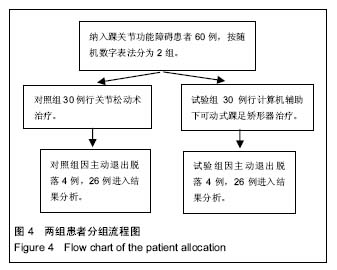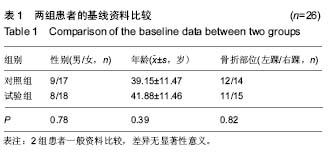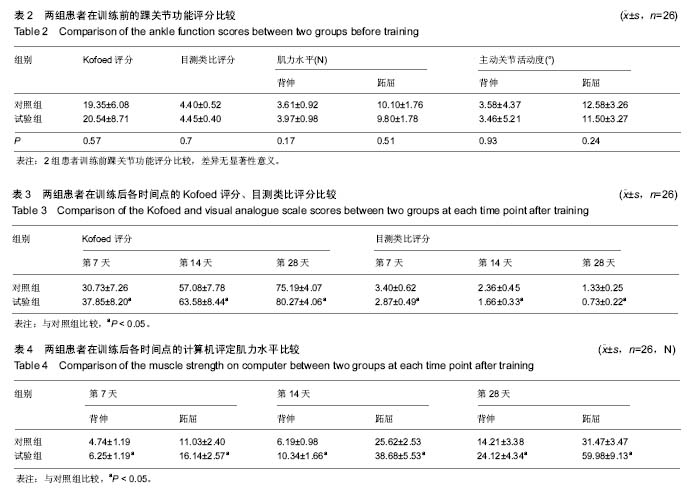| [1] 胥少汀,葛宝丰,徐印坎.实用骨科学[M].3版.北京:人民军医出版社,2005:792-803.[2] Goost H,Wimmer MD,Barg A,et al.Fractures of the ankle joint:investigation and treatment options. Dtsch Arztebl Int. 2014;111(21):377-388. [3] Shaffer MA,Okereke E,Esterhai JL Jr, et al. Effects of immobilization on plantar-flexion torque, fatigue resistance, and functional ability following an ankle fracture. Phys Ther. 2000;80(8):769-780.[4] 赵辉三.肢残康复20年,假肢矫形器服务的发展与挑战[J].中国矫形外科杂志,2007,15(7):481-483.[5] 冉春风.可动式踝足关节计量矫形器[P].中国:发明专利, 200810067751.X ,2008.[6] 闫国钦,张占伟, 张军平,等.踝关节骨折内固定术后早期康复训练对患者关节功能的改善作用[J].中国实用医刊,2015,42(17): 109-110.[7] 陆泓 汪友兰.手法整复结合康复治疗踝关节骨折患者临床疗效观察[J].现代诊断与治疗,2014,25(23):5424-5425.[8] 刘欣,王磊,陈先,等.早期介入康复治疗对Pilon骨折手术后踝关节功能的影响[J].中国康复医学杂志,2014,29(3):269-271.[9] 赵为公,杨益民,王莹,3D打印技术结合数字化技术在复杂踝关节[J].医学综述,2015,21(22):4141-4143.[10] 孙艳华,李秀娟,张娱.中药离子透入治疗踝关节疼痛10例[J].云南中医中药杂志,2011,32(8):94.[11] Buza JA 3rd, Einhorn T. Bone healing in 2016. Clin Cases Miner Bone Metab. 2016;13(2):101-105.[12] Porter DA,Jaggers RR,Barnes AF,et al.Optimal management of ankle syndesmosis injuries.Open Access J Sports Med. 2014;5(5):173-182.[13] 李永舵,刘书茂,贾金生,等.后踝骨折内固定方法的选择:生物力学及临床应用研究[J].北京大学学报:医学版,2011,43(5): 718-723.[14] Zhu ZJ, Zhu Y, Liu JF, et al. Posterolateral ankle ligament injuries affect ankle stability: a finite element study. BMC Musculoskelet Disord. 2016;17:96.[15] Kobayashi T, Gamada K. Lateral Ankle Sprain and Chronic Ankle Instability: A Critical Review. Foot Ankle Spec. 2014; 7(4):298-326.[16] Hao ZT, Ma YX, Hao T, et al. Comparison of surgical intervention with functional treatment for acute ruptures of lateral ankle ligmant: a meta-analysis. Asian Pac J Trop Med. 2012;5(5):396-401.[17] Kannus P, Palvanen M, Niemi S, et al. Increasing number and incidence of low-trauma ankle fractures in elderly people: Finnish statistics during 1970-2000 and projections for the future. Bone. 2002;31(3):430-433.[18] Court-Brown CM, McBirnie J, Wilson G. Adult ankle fractures--an increasing problem? Acta Orthop Scand. 1998; 69(1):43-47.[19] Jensen SL, Andresen BK, Mencke S, et al. Epidemiology of ankle fractures:a prospective population-based study of 212 cases in Aalborg, Denmark. Acta.Orthop Scand. 1998;69(1):48-50.[20] Gunnes M, Mellström D, Johnell O. How well can a previous fracture indicate a new fracture? A questionnaire study of 29,802 postmenopausal women. Acta Orthop Scand. 1998; 69(5):508-512.[21] Van Schie-Van der Weert EM, Van Lieshout EM, De Vries MR, et al. Determinants of outcome in operatively and non-operatively treated Weber-B ankle fractures. Arch Orthop Trauma Surg. 2012;132(2):257-263. [22] Polzer H, Kanz KG, Prall WC, et al.Diagnosis and treatment of acute ankle injuries: development of an evidence-based algorithm. Orthop Rev (Pavia). 2012;4(1):e5.[23] Miyamoto W, Takao M. Management of chronic disruption of the distal tibiofibular syndesmosis. World J Orthop. 2011;2(1): 1-6.[24] Imade S, Takao M, Miyamoto W, et al. Leg anterior compartment syndrome following ankle arthroscopy after Maisonneuve fracture. Arthroscopy. 2009;25: 215-218. [25] Koval KJ, Lurie J, Zhou W, et al. Ankle fractures in the elderly: what you get depends on where you live and who you see. J Orthop Trauma. 2005;19(9): 635-639.[26] Makwana NK, Bhowal B, Harper WM, et al. Conservative versus operative treatment for displaced ankle fractures in patients over 55 years of age. A prospective, randomised study. J Bone Joint Surg Br. 2001;83(4): 525-529.[27] Michelson JD, Magid D, McHale K. Clinical utility of a stability-based ankle fracture classification system. J Orthop Trauma. 2007;21(5):307-315.[28] Ramsey PL, Hamilton W.Changes in tibiotalar area of contact caused by lateraltalar shift. J Bone Joint Surg Am. 1976;58(3): 356-357.[29] Angthong C. Ankle fracture configuration following treatment with and without arthroscopic-assisted reduction and fixation. World J Orthop. 2016;7(4):258-264.[30] Rios JL, Gorges AL, dos Santos MJ. Individuals with chronic ankle instability compensate for their ankle deficits using proximal musculature to maintain reduced postural sway while kicking a ball. Hum Mov Sci. 2015;43:33-44.[31] Pfeifer CG,Grechenig S,Frankewycz B,et al. Analysis of 213 currently used rehabilitation protocols in foot and ankle fractures. Injury. 2015;46 (4):S51-57.[32] 中华医学会骨质疏松和骨矿盐疾病分会.原发性骨质疏松症诊治指南[J].中华骨质疏松和骨矿盐疾病杂志,2011,4(1):2-17.[33] Black JD,Bhavikatti M,Al-Hadithy N,et al.Early weight-bearing in operatively fixed ankle fractures: A systematic review. Foot (Edinb). 2013;23(2-3):78-85.[34] Dehghan N,McKee MD,Jenkinson RJ,et al.Early weightbearing and range of motion versus non-weightbearing and immobilization after open reduction and internal fixation of unstable ankle fractures: a randomized controlled trial. J Orthop Trauma. 2016;30(7):345-352.[35] Sarmiento A, Schaeffer JF, Beckerman L,et al. Fracture healing in rat femora as affected by functional weight-bearing. J Bone Joint Surg Am. 1977;59:369-375.[36] Fisher BE,PirainoA,Lee YY,et al.The effect of velocity of joint mobilization on corticospinal excitability in individuals with a history of ankle sprain.J Orthop Sports Phys Ther. 2016;46(7): 562-570.[37] An CM,Won JI.Effects of ankle joint mobilization with movement and weight-bearing exercise on knee strength,ankle range of motion,and gait velocity in patients with stroke:a pilot study. J Phys Ther Sci. 2016;28(2):689-694.[38] Chen X, Xu L, Wang W,et al. Computer-aided design and manufacturing of surgical templates and their clinical applications: a review. Expert Rev Med Dev. 2016;13(9):853-864.[39] Bilgin MS, Baytaro?lu EN, Erdem A, et al. A review of computer-aided design/computer-aided manufacture techniques for removable denture fabrication.Eur J Dent. 2016;10(2):286-291.[40] Cobetto N, Aubin CE, Parent S, et al.Effectiveness of braces designed using computer-aided design and manufacturing (CAD/CAM) and finite element simulation compared to CAD/CAM only for the conservative treatment of adolescent idiopathic scoliosis: a prospective randomized controlled trial. Eur Spine J. 2016;25(10):3056-3064. |
.jpg)





.jpg)
.jpg)